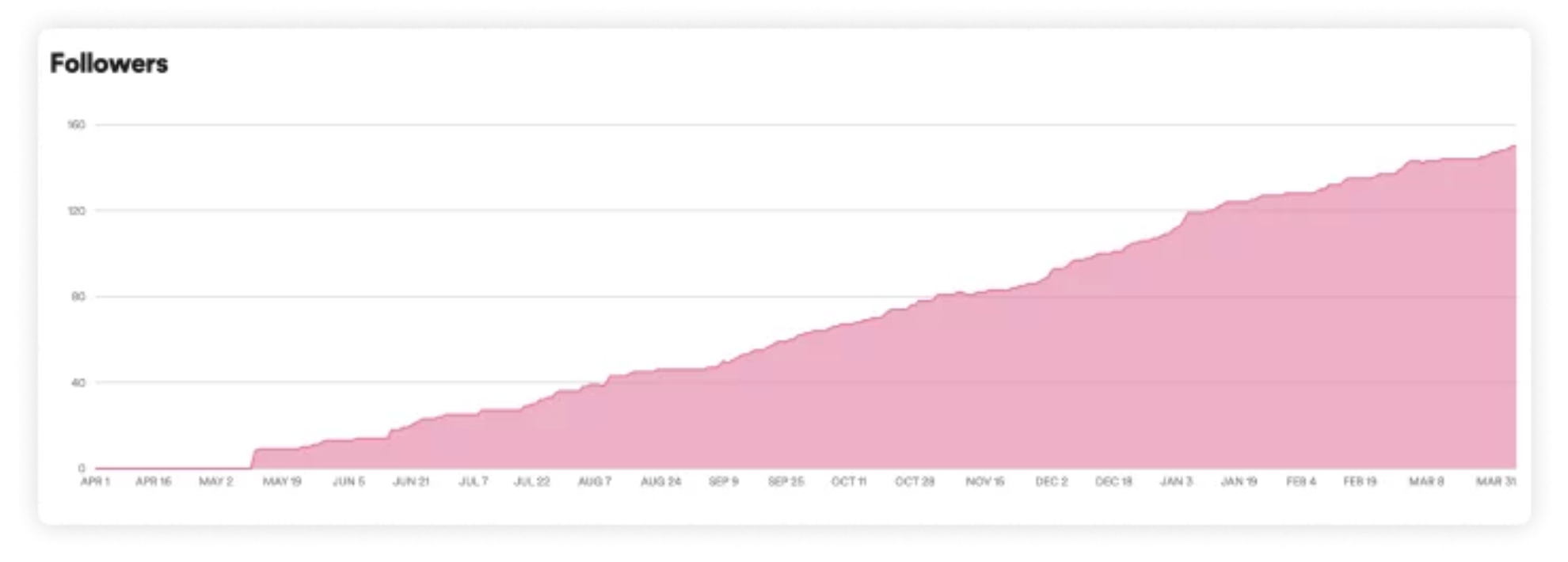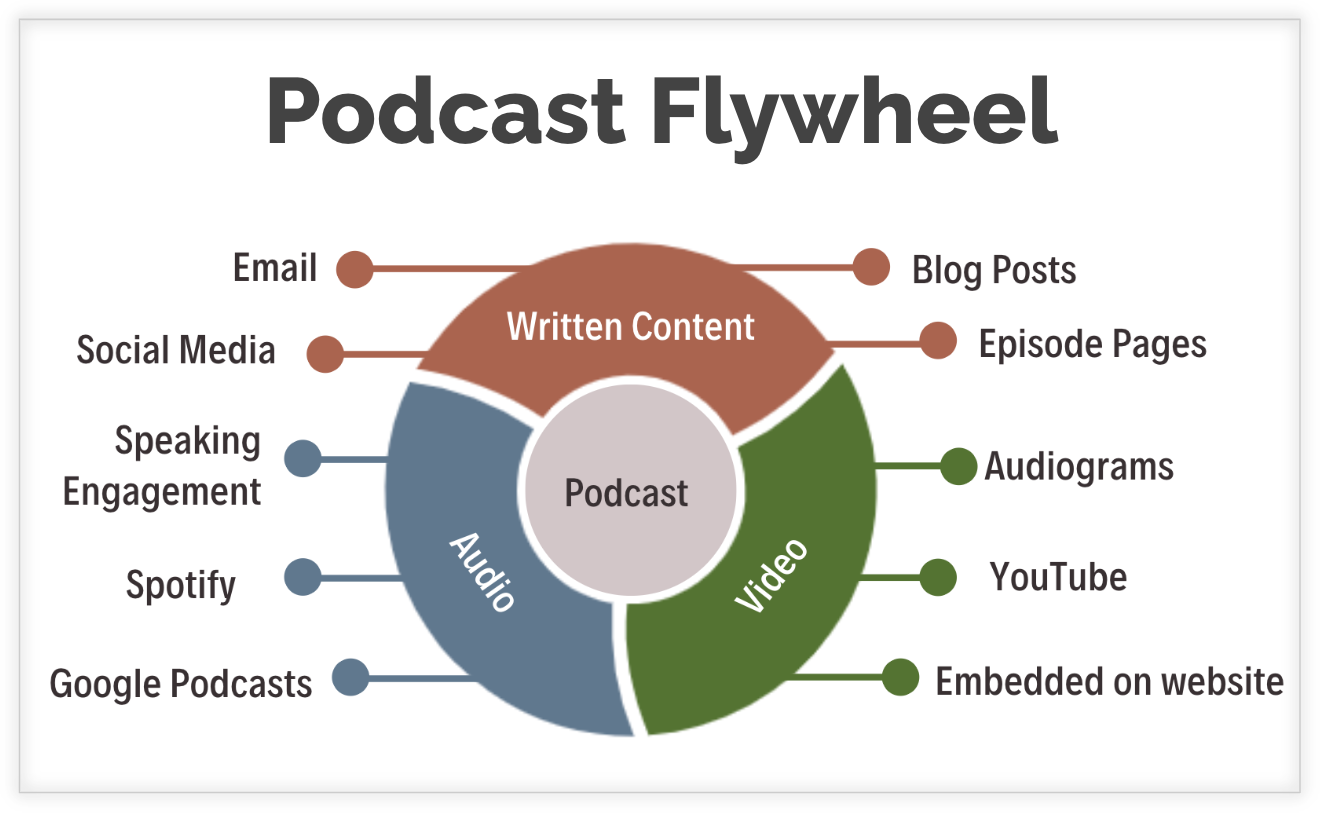How to Grow a Business Podcast in 2024
Starting a business podcast is an accomplishment. But it’s only the first step. How will you attract listeners? What milestones should you look for along the way? According to Podcast Industry Insights in Q3, 2023 less than 18% (459,000) of podcasts were active, having released a new episode within the most recent 90 days. Most podcasts fail to reach 10 episodes. This article will help you learn how to grow a business podcast.
Set realistic expectations for stakeholders
First and foremost, you need to set the right expectations for stakeholders. That starts by connecting your podcast to business goals and identifying the benefits of podcasting that apply to your company.
In my experience, podcast growth is linear. You win over a few listeners at a time. When I was hosting the Digital Marketing Troop podcast—a weekly show—we gained about a dozen followers each week on Spotify. I documented the growth of that podcast here. Here’s how that growth looked:
While follower growth and downloads doesn’t impact the bottom line, there are other ways to show a podcast is having a meaningful impact on revenue. Recently, I interviewed Allyson Cochran, Chief Revenue Officer at Silverback Strategies, about the impact our show, Digital Marketing Troop, had on the agency. Here’s Allyson:
Identify your distribution channels
Podcasts can be consumed on Apple Podcasts, Spotify, and other podcast listening platforms. But those audio-only channels represent only a fraction of the ways to distribute your podcast content. The illustration below shows an example of how podcast content can be distributed on audio, video, and text-based channels.
Promote new episodes
Regularly distribute new episode content to subscribers and followers. Below are some examples of how you can promote your episode content across audio, video, and text-based channels. If you want more in-depth content, read this article about specific ways to promote a podcast for business.
Audio Channels
Podcasts originated as an audio-only content format. iPhone users have a podcast application pre-loaded on their phones. Subscribers to your show will receive notifications of new episode content directly on their devices. According to Filmora, Tuesday, Wednesday, and Thursday mornings between 2:00 am and 5:00 am are the best times to release podcast episodes.
When I co-hosted and produced the Visible Expert podcast, we released episode content on Mondays at 5:00 am EST. Digital Marketing Troop episodes were released at 6:00 am EST on Wednesdays.
You can also leverage audio channels in your written content. For example, you can embed a feed of recent podcast episodes, like the one below:
Video Channels
A good social media strategy is one of the best ways to grow a podcast. Today, videos perform well on social media channels. You can use audiograms, which are short videos, between 30 seconds and 1-2 minutes long, with a static background, a dynamic waveform visual, and subtitles. These videos are great at grabbing attention in the feed. You can create them easily with tools like headliner.app.
You can also promote your podcast on YouTube. You don’t have to launch your business podcast as a video show, but you can grow into it over time. For example, I launched a YouTube channel to showcase ~5-minute videos from each of my guests on A/V Marketing. In the video below, Aaron Weiche, Co-Founder and CEO of Leadferno, talks about the impact of his podcast, Conversion Cast:
Text-Based Channels
Not only can users find your episodes on podcast platforms, but your website can also attract organic search traffic. Individual episode webpages can be more than just a media player and a transcript. Include a bio for the host and guests. Re-write the transcript in a journalism-style article.
Users can subscribe to your podcast on platforms like Spotify, Apple and Google. But you can also offer a way for users to subscribe to your show via email. Create a form for your website that puts conversions onto a “subscriber” list. When new episodes are published, you can send them an email directly. This is another channel for listeners to consume your content. For example, I turned episodes of A/V Marketing into a free email course: 12 emails over 30 days with resources, frameworks, templates, and actionable steps to help you get closer to launching your show. Subscribe here:
Finally, the personal brand of the podcast host(s) is an amplifier. The more social you are on platforms like LinkedIn and Twitter, the greater chance you will grow your show.
How to Grow a Business Podcast: Establish Repeatable Workflows
The most important part of promoting new episode content is to have repeatable podcast editing workflows. With the right systems in place, you’ll have an efficient content-creation machine. Here are some workflows to consider:
Audio editing
Creating audiogram videos
Transcription clean-up
Turning episodes into blog content
Adding media players to existing blog posts
Sending new episodes to email subscribers
Keyword research
Distribute existing business podcast content
Want to learn how to grow a business podcast? Focus on distribution. Don’t let your existing podcast content collect dust. With a business podcast, the content topics are often evergreen. New subscribers this month probably haven’t heard episode content from last quarter. If you have a good podcast marketing strategy, past episodes should still be relevant.
Here are a few ways to re-distribute older podcast episodes:
Email nurture tracks
Sales enablement
Social media
Topic research
Guest outreach
Email nurture tracks
Some B2B and professional services firms set up automated email nurture campaigns to help educate prospects and deposit value. Existing podcast episodes are great to include in your email nurture tracks because there is a chance users would prefer audio content over long-form written content.
Or, you could work existing podcast content into your weekly newsletter. This content marketing framework can be an effective way to re-promote existing podcast content. New subscribers this month didn’t see the podcast episode you published 3 months ago. See the illustration below.
Sales enablement
If you have a podcast conversation with an ideal customer or prospect, depending on the conversation, more folks like that person would find it valuable or entertaining. Sales professionals can use podcast episodes as sales enablement content. For example, at Silverback Strategies, I interviewed a client from Oregon State University about his experience building a full-funnel marketing strategy in the higher education industry. Our sales team shared that interview with other prospects in the vertical. Listen to that podcast episode below.
Social media
New followers this month didn’t see what you posted two months ago. That’s why it’s important to recycle and re-promote your existing content on social media. Audiograms that you created to promote new episodes can be worked in periodically to your social calendars. Especially Twitter, where the lifespan of a single Tweet is about 20 minutes.
Topic research
Curiosity is a superpower. Especially for podcast hosts. The more you research a topic, the more content you can extract from guests or even speak about yourself. This research will lead to new episode ideas and deepen relationships.
Guest outreach
If your show is interview-based, someone on your podcast team will need to manage prospective guests much like a sales pipeline. Depending on the guest, you may need to coordinate a time weeks, possibly months, in advance. This can make it difficult to project out your podcast calendar.
Conversely, if your strategy calls for you to be a guest on other podcasts, you may need to do outreach to pitch yourself to established podcast hosts. There are pros and cons to podcast guesting vs hosting, but each can be an effective way to build authority and visibility in your niche.
Batch recording
Publishing consistently every week doesn’t mean you need to do one podcast interview each week. Instead, one useful tactic is to “batch” recordings together. This way, you can build out a buffer in your podcast calendar. Doing this can be useful if you have a big project coming up, or would like to take some much-needed PTO.
Recycling content — publishing podcast content consistently over time is great. But sometimes, it’s worth re-surfacing audio clips from past episodes, or turning webinars or live events into a podcast episode.
How to Grow a Business Podcast: Measure Performance Regularly
Measuring show performance will depend on how you’re using your podcast, and what kind of impact you’re trying to have on the organization. In most cases, there will be the question of “how does this impact revenue?”
And the answer is simple, a podcast allows you to reach your target buyers on channels—and at times in their routines—you wouldn’t be able to with other traditional or digital media.
Here are some indicators to tell if your podcast is having an impact:
Let’s grow your podcast together
Red Cedar Marketing helps B2B and professional services firms differentiate their marketing strategy with podcast media. Whether you need a coach to show you how to launch your own podcast, or you need a fully-outsourced podcast partner, we can help. Speak with an expert today.




